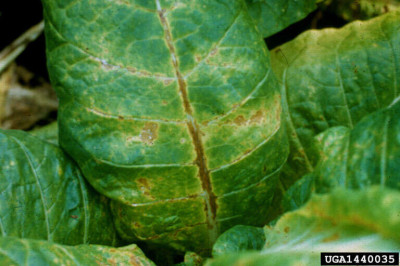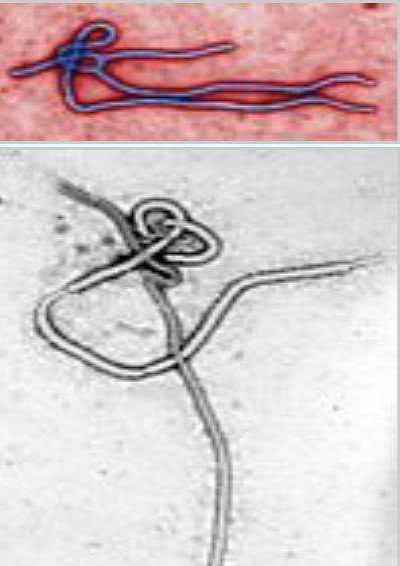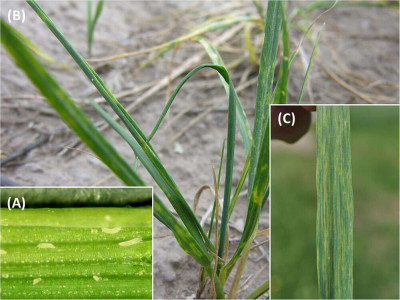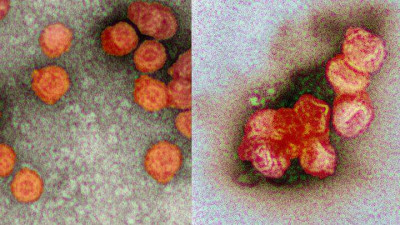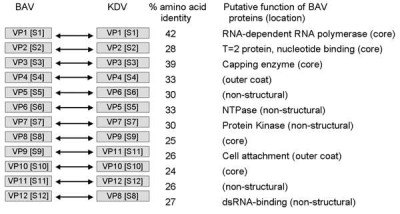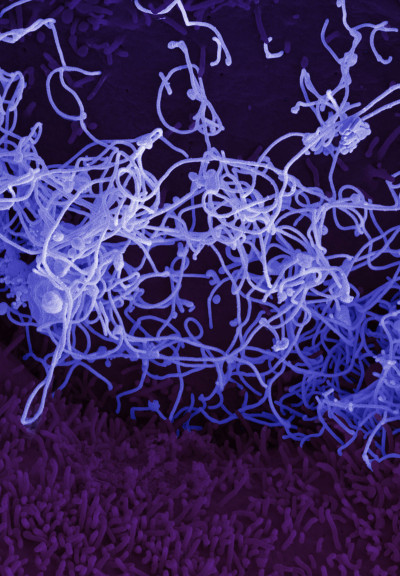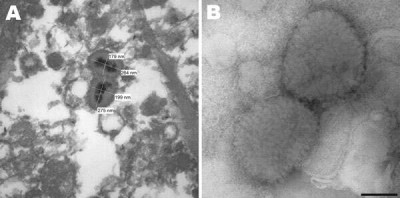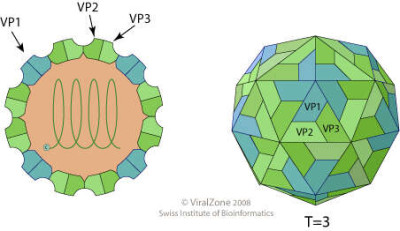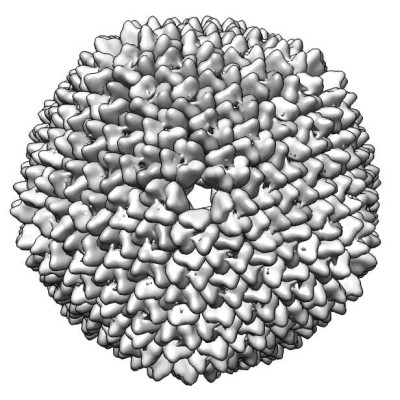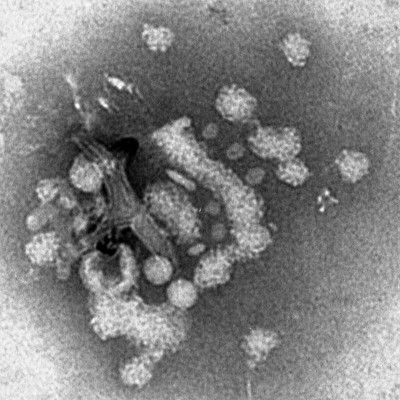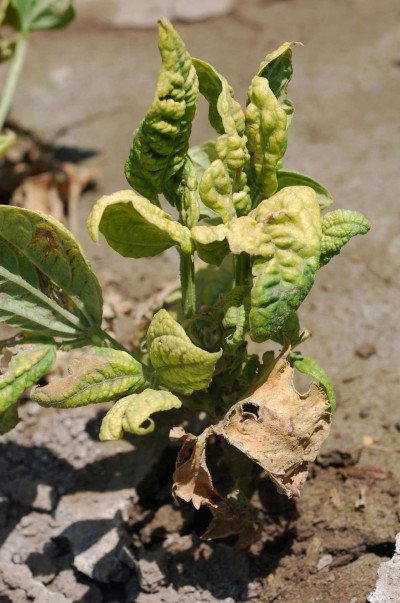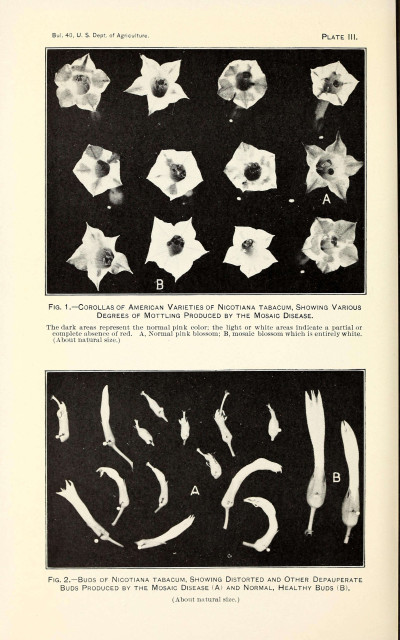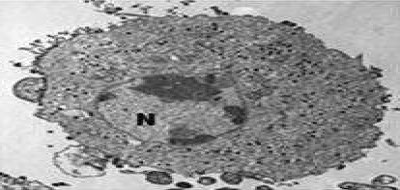The initial symptom of TVMV infection is a slight, barely visible clearing on expanding leaves. Subsequently, leaves develop irregular green patterns of mottling adjacent to the veins; this is most evident on the ruffles at the base of older leaves. Chlorosis of infected leaves is extensive, giving the plants a pale green or yellow appearance which may be evident from a distance. Necrotic spotting of the leaf, indistinguishable from weather fleck, may develop and become increasingly prevalent as plants mature. The earlier that plants are infected with the virus, the greater the damage. The virus overwinters in perennial solanaceous weeds and is transmitted to tobacco by aphids. The virus is often found in combination with TEV. TVMV is also one of the most prevalent viruses in burley.
Wikimedia Commons, R.J. Reynolds Tobacco Company, Bugwood.org
14 Mar 2024
Schematic drawing of a virus particle from the family Virgaviridae.
ViralZone, SIB Swiss Institute of Bioinformatics, Wikimedia Commons
14 Mar 2024
Colorized transmission electron micrograph of monkeypox particles (yellow) found within an infected cell (red), cultured in the laboratory. Image captured at the NIAID Integrated Research Facility (IRF) in Fort Detrick, Maryland.
Wikimedia Commons
08 Apr 2024
This transmission electron micrograph (TEM) revealed the presence of the human parainfluenza type 4A virus (HPIV-4A), which like the mumps virus, is also a Paramyxoviridae family member, and a member of the genus, Rubulavirus.
Public Health Image Library
11 Apr 2024
Wheat curl mite (WCM) and wheat streak mosaic virus (WSMV) symptoms: (A) specimens of WCM on a wheat leaf; (B) leaf curls caused by WCM; and (C) WSMV symptoms on wheat leaf. [1]
Anna Skoracka, Brian G. Rector Brian, and Gary L. Hein
18 Apr 2024
Genomic structure of Plum pox potyvirus.
Wikimedia Commons, xmort
18 Apr 2024
Virions of Pseudomonas virus phi6, colored. Left: normal. Right: coagulated.
Wikimedia Commons, Shankar Chellam/Texas A&M Engineering
18 Apr 2024
Maximum-likelihood tree showing phylogenetic relationships between Cygnet River virus isolate 10–01646 (GenBank accession no. JQ693418) and other orthomyxoviruses: Quaranfil virus isolate EG T 377 (accession no. GQ499304), Thogoto virus strain PoTi503 (accession no. AF527530), infectious salmon anemia virus isolate RPC/NB (accession no. AF435424), influenza C virus C/Yamagata/8/96 (accession no. AB064433), influenza B virus B/Wisconsin/01/2010 (accession no. CY115184), and influenza A virus A/California/07/2009(H1N1) (accession no. CY121681). Tree was based on deduced amino acid sequences of the complete matrix protein of orthomyxoviruses, applying 1,000 bootstrap replicates. Numbers at nodes indicate percentage of 1,000 bootstrap replicates. Scale bar indicates nucleotide substitutions per site. [1]
Wikimedia Commons, Allan Kessell, Alex Hyatt, Debra Lehmann, Songhua Shan, Sandra Crameri, Clare Holmes, Glenn Marsh, Catherine Williams, Mary Tachedjian, Meng Yu, John Bingham, Jean Payne, Sue Lowther, Jianning Wang, Lin-Fa Wang, and Ina Smith
23 Apr 2024
Comparison of nucleotide and amino acid sequences of genome segments of viral proteins (VP) and dsRNA segments (S) of Banana virus (BAV) and Kadipiro virus (KDV). NTP, nucleoside triphosphatase.
Wikimedia Commons, Houssam Attoui, Fauziah Mohd Jaafar, Philippe de Micco, and Xavier de Lamballerie
29 Apr 2024
Ebola virus isolated in November 2014 from patient blood samples obtained in Mali. The virus was isolated on Vero cells.
NIAID, Wikimedia Commons
24 Jan 2024
A) Electron micrograph of poxvirus particles in synovium of a big brown bat, northwestern United States. B) Negative staining of poxvirus particles in cell culture supernatant. Scale bar = 100 nm. [1]
Wikimedia Commons
25 Jan 2024
Schematic drawing of a virion of the family Marnaviridae, cross section and side view.
ViralZone, SIB Swiss Institute of Bioinformatics
01 Mar 2024
High-resolution epitope maps of antibodies against Ebola glycoprotein (red and yellow spirals), determined using shotgun mutagenesis epitope mapping. Epitope maps provide data for determining the mechanism of action of an antibody.
Kathryn Edmondson, Wikimedia Commons
01 Mar 2024
CryoEM model of Bacteriophage Prd1 Capsid. PDB entry 1gw7.
A2-33, Wikimedia Commons
01 Mar 2024
Enterovirus virions in Rigvir drug active substance. Electron microphotography (magnification 150 000x) The negative staining method.
Wikimedia Commons, Redijs
08 Mar 2024
Highlighted in the image are the fragmented canopies of swamp bald cypress in coastal Louisiana. The larger openings created by these unhealthy fragmented canopies let more light to penetrate under the canopies, hence increasing the risk of invasion by outsiders.
11 Mar 2024
A dry bean plant showing symptoms of beet curly top virus (BCTV) infection in the field. [1]
Howard F. Schwartz, Colorado State University, Bugwood.org
13 Mar 2024
Corollas of American varieties of Nicotiana tabacum, showing various degrees of mottling produced by the mosaic disease.[1]
Wikimedia Commons, Allard, H. A.
14 Mar 2024
Transmission electron micrographs of FHM cells infected by Frog virus 3 (FV3). Virus-infected cell in which virions are scattered throughout the cytoplasm. [1]
Wikimedia Commons, Jancovich, J.K., Qin, Q., Zhang, QY., Chinchar, V.G.
14 Mar 2024
 Encyclopedia
Encyclopedia
